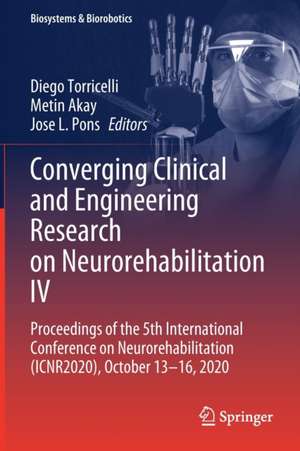Converging Clinical and Engineering Research on Neurorehabilitation IV: Proceedings of the 5th International Conference on Neurorehabilitation (ICNR2020), October 13–16, 2020: Biosystems & Biorobotics, cartea 28
Editat de Diego Torricelli, Metin Akay, Jose L. Ponsen Limba Engleză Paperback – 3 oct 2022
| Toate formatele și edițiile | Preț | Express |
|---|---|---|
| Paperback (1) | 2899.14 lei 6-8 săpt. | |
| Springer International Publishing – 3 oct 2022 | 2899.14 lei 6-8 săpt. | |
| Hardback (1) | 2906.81 lei 6-8 săpt. | |
| Springer International Publishing – 2 oct 2021 | 2906.81 lei 6-8 săpt. |
Din seria Biosystems & Biorobotics
-
 Preț: 124.32 lei
Preț: 124.32 lei - 5%
 Preț: 2086.52 lei
Preț: 2086.52 lei - 5%
 Preț: 724.29 lei
Preț: 724.29 lei - 5%
 Preț: 738.41 lei
Preț: 738.41 lei - 5%
 Preț: 715.55 lei
Preț: 715.55 lei - 5%
 Preț: 406.56 lei
Preț: 406.56 lei - 15%
 Preț: 642.18 lei
Preț: 642.18 lei - 5%
 Preț: 3238.02 lei
Preț: 3238.02 lei - 5%
 Preț: 1110.52 lei
Preț: 1110.52 lei - 5%
 Preț: 1407.51 lei
Preț: 1407.51 lei - 5%
 Preț: 841.53 lei
Preț: 841.53 lei - 5%
 Preț: 1304.55 lei
Preț: 1304.55 lei - 15%
 Preț: 635.96 lei
Preț: 635.96 lei - 5%
 Preț: 1431.66 lei
Preț: 1431.66 lei - 20%
 Preț: 652.73 lei
Preț: 652.73 lei - 18%
 Preț: 1212.84 lei
Preț: 1212.84 lei - 5%
 Preț: 708.23 lei
Preț: 708.23 lei - 5%
 Preț: 1936.01 lei
Preț: 1936.01 lei - 5%
 Preț: 1092.79 lei
Preț: 1092.79 lei - 5%
 Preț: 713.54 lei
Preț: 713.54 lei - 18%
 Preț: 1215.53 lei
Preț: 1215.53 lei - 5%
 Preț: 725.42 lei
Preț: 725.42 lei - 5%
 Preț: 722.12 lei
Preț: 722.12 lei - 5%
 Preț: 710.79 lei
Preț: 710.79 lei - 5%
 Preț: 2145.17 lei
Preț: 2145.17 lei
Preț: 2899.14 lei
Preț vechi: 3051.73 lei
-5% Nou
Puncte Express: 4349
Preț estimativ în valută:
554.74€ • 579.20$ • 459.12£
554.74€ • 579.20$ • 459.12£
Carte tipărită la comandă
Livrare economică 05-19 aprilie
Preluare comenzi: 021 569.72.76
Specificații
ISBN-13: 9783030703189
ISBN-10: 3030703185
Pagini: 975
Ilustrații: XXI, 975 p. 299 illus., 273 illus. in color.
Dimensiuni: 155 x 235 mm
Greutate: 1.37 kg
Ediția:1st ed. 2022
Editura: Springer International Publishing
Colecția Springer
Seria Biosystems & Biorobotics
Locul publicării:Cham, Switzerland
ISBN-10: 3030703185
Pagini: 975
Ilustrații: XXI, 975 p. 299 illus., 273 illus. in color.
Dimensiuni: 155 x 235 mm
Greutate: 1.37 kg
Ediția:1st ed. 2022
Editura: Springer International Publishing
Colecția Springer
Seria Biosystems & Biorobotics
Locul publicării:Cham, Switzerland
Cuprins
How to challenge patients during gait training: The effect of immersive virtual reality on the gait pattern in people post-stroke.- Automatic versus Manual Tuning of Robot-Assisted Gait Training.- Six weeks use of a wearable soft-robotic glove during ADL: preliminary results of ongoing clinical study.- Proof-of-concept of POF-based pressure sensors embedded in a smart garment for impact detection in perturbation assessment.-Influence of innovative rehabilitation technology on intensity of training: preliminary results.- Challenges in adaptive robot-assisted gait training: the balancing act of minimizing assistance while preserving safety.
Textul de pe ultima copertă
The book reports on advanced topics in the areas of neurorehabilitation research and practice. It focuses on new methods for interfacing the human nervous system with electronic and mechatronic systems to restore or compensate impaired neural functions. Importantly, the book merges different perspectives, such as the clinical, neurophysiological, and bioengineering ones, to promote, feed and encourage collaborations between clinicians, neuroscientists and engineers. Based on the 2020 International Conference on Neurorehabilitation (ICNR 2020) held online on October 13-16, 2020, this book covers various aspects of neurorehabilitation research and practice, including new insights into biomechanics, brain physiology, neuroplasticity, and brain damages and diseases, as well as innovative methods and technologies for studying and/or recovering brain function, from data mining to interface technologies and neuroprosthetics. In this way, it offers a concise, yet comprehensive referenceguide to neurosurgeons, rehabilitation physicians, neurologists, and bioengineers. Moreover, by highlighting current challenges in understanding brain diseases as well as in the available technologies and their implementation, the book is also expected to foster new collaborations between the different groups, thus stimulating new ideas and research directions.
Caracteristici
Reports on cutting-edge developments in robot-assisted rehabilitation Gives new insights into the understanding of motor control and neural function Fosters communication between engineers, industry and medical professionals
